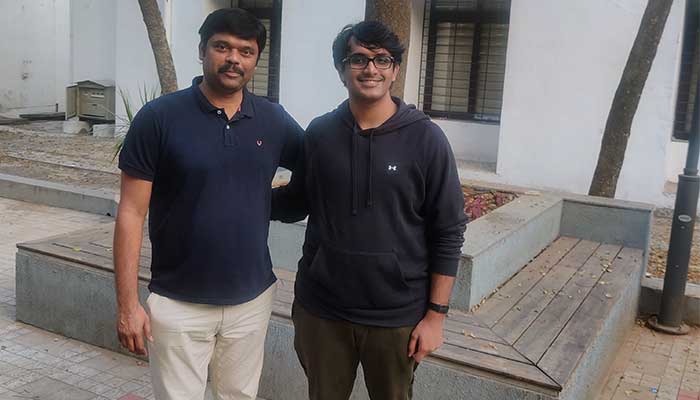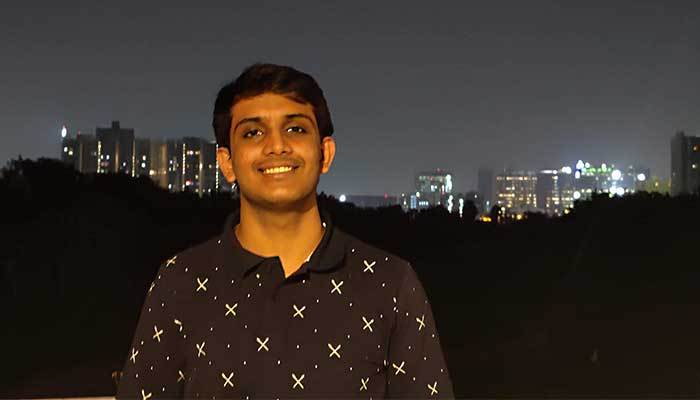Dual degree student, Anirudh Palutla from the Centre for Computational Natural Sciences and Bioinformatics (CCNSB) is all set to unravel biological enigmas at the Janelia Research Campus in Virginia, US.
Anirudh Palutla may appear as a young man of leisure even as he laces up, draws in his breath and takes off on a recreational run. But it hasn’t always been like this for him. It is only now upon completion of his dual degree program (BTech in Computer Science and Master of Science in Computational Natural Sciences by Research) that he has time to indulge in hobbies. “Back when my thesis was still underway, especially during my final year of research, it was definitely challenging to indulge in other pursuits with research constantly on my mind. But since submitting my thesis though, I’ve had a lot of time to explore and try out new things,” offers Anirudh as explanation. The respite may be short lived though as he will soon take on a new position of Scientific Computing Associate at Janelia Research Campus (JRC), Virginia, USA, which is a scientific research campus of the Howard Hughes Medical Institute. JRC’s primary mission is to solve crucial biomedical problems with a focus on interdisciplinary collaboration between experts from various domains.
Trailblazing Through An Interdisciplinary World
“There hasn’t been a case at the Centre for Computational Natural Sciences and Bioinformatics (CCNSB) where a student directly joined a prominent research team right after completing the dual-degree program. This achievement is truly the first of its kind. He will be engaged in computer-aided neuroscience and protein engineering with a leading research team at JRC,” remarks Prof. Marimuthu Krishnan, under whom Anirudh officially kickstarted his undergraduate research in the field of protein dynamics.

Though he began by using the principles of statistical physics for protein simulation, over time, it was neuroscience that kindled Anirudh’s interest leading him to work with the application of statistical mechanics in neuroscience. “I always had the interest to explore state-of-the-art computational techniques and tools, and one of my main interests in computer science was machine learning,” he says, adding, “The endless potential of ML never ceased to amaze me, and this interest of mine drove me to work under Dr. Kamalakar Karlapalem as a Research Associate (RA) on analysing the performance of large language models on a variety of tasks.” It was during this tenure as RA that thanks to Dr. Karlapalem, Anirudh began a collaborative project with Dr. Srinivas Turaga and Dr. John Koberstein of JRC. Dr. Turaga and his team applies machine learning algorithms to map neural connectivity. “We essentially began exploring the use of protein language models to improve the function of a particular protein – which is a genetically-encoded fluorescent indicator – through ML-assisted directed evolution,” shares Anirudh. Calling it a Biology problem within Neuroscience that uses Machine Learning, Anirudh simplifies it further by stating that his work is on designing better proteins which when injected into the brain’s neurons light up based on the activity triggered in the brain.
Soon Anirudh began collaborating with Dr. Alison Tebo’s lab (at JRC) as well, which focuses on developing protein-based tools for improving screening methodologies. “Coming from a background of working both with proteins and neuroscience, coupled with an interest in ML, working at these labs was the perfect fit for me,” he declares.
The IIITH Edge
For Anirudh who professes a “very, very large” interest in Physics from the start, choosing the dual degree program in Computational Natural Sciences (CND) was easy. “We are exposed to a wide variety of courses in the CND curriculum,” says Anirudh, continuing, “I would say it’s more wide than deep”. From pure quantum mechanics, to statistical mechanics, to biological field systems and more, the world is really their oyster for graduating CND students. According to Prof. Krishnan, the CND program is designed to produce skilled individuals capable of addressing advanced scientific research challenges through computational methods. “Students pursuing this program conduct their research at CCNSB, completing their Master’s thesis and consistently publishing in reputed international journals and conferences at a young age. CCNSB anticipates that many of these students will pursue research careers, collaborating with leading international research teams and contributing significantly to the expansion of scientific knowledge. While some graduates enter the software industry, a majority continue their studies at prestigious universities abroad,” he says.
Speaking about protein engineering, Anirudh muses that it’s a novel field with unlimited potential. “There have been numerous advances and more specifically by machine learning which has pushed this field of protein engineering forward by a significant amount. And we’re able to now solve problems that we’ve barely made any progress in for multiple decades,” he states. As a IIITH student, for him, the exposure to machine learning came from the very start. “We have great infrastructure for it and a sizeable number of courses that teach us ML.” With Janelia Research Campus being an interdisciplinary centre, much like IIITH itself, he says that he has had the opportunity to work with very smart and diverse people. “At JRC, for instance, my group leader for the project is an ML expert, my partner John is a Biologist and so on. It’s really amazing that I get to meet people from different backgrounds,” says Anirudh.
Implore to Explore!
For others who may be charting out a similar path as his, Anirudh has this to say: “There’s a lot of excellent work going on in IIITH and unfortunately as students, the schedule is very hectic, often leaving us with very little energy after classes. But if you can muster up that energy and courage and go and talk to people (the professors), you’ll discover there’s a lot to explore here.” He signs off expressing his gratitude to his advisor Prof. Krishnan for playing a pivotal role in establishing a solid foundation and Prof. Karlapalem and the supervisors at JRC for giving him the opportunity to pursue his interest at JRC. “I’m also grateful to Dr. Ashwin SS, an independent researcher, who taught me a lot about how to approach problems and think of them structurally,” he says.



Next post